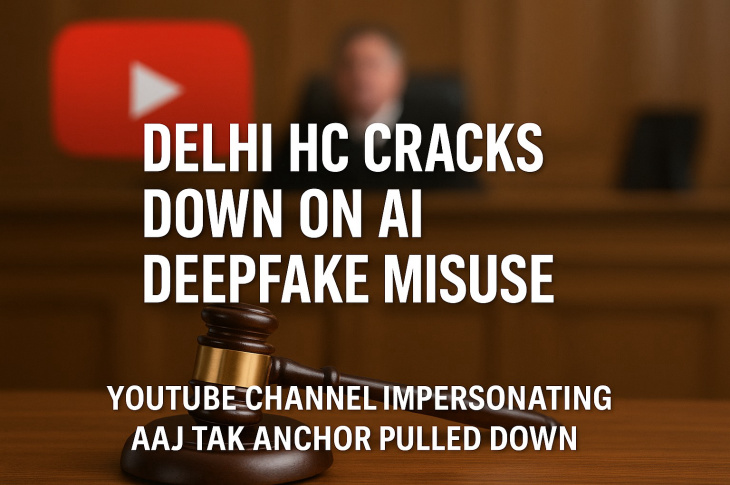HC Takes Strong Action Against AI-Misuse: YouTube Deepfake of Aaj Tak Anchor Pulled Down
Introduction: The Rise of Deepfake Threats in India
Artificial Intelligence (AI) is transforming how we live, work, and communicate. But with its growing power comes significant risks—particularly the misuse of deepfake technology. Deepfakes are AI-generated videos or audio clips that manipulate a person’s likeness to say or do things they never actually did. While sometimes used for entertainment, deepfakes are increasingly being weaponized to spread misinformation, defame individuals, and exploit public trust.
In a crucial development, the Delhi High Court has taken a firm stand against such AI-driven misuse. The Court ordered the immediate removal of a YouTube channel that used deepfake technology to impersonate renowned journalist Anjana Om Kashyap, anchor and Managing Editor at Aaj Tak. This case marks a significant precedent for combating AI-based impersonation and protecting media credibility.
People Also Read: How To Report Cyber Blackmailing In India
What Are Deepfakes and Why Are They Dangerous?
Before diving into the legal details of the case, let’s understand what deepfakes are.
What Are Deepfakes?
Deepfakes use AI and machine learning algorithms—particularly a method called GANs (Generative Adversarial Networks)—to create highly realistic fake audio, video, or images. These creations can convincingly mimic public figures, celebrities, or even ordinary individuals.
Dangers of Deepfakes
-
Misinformation: They can spread fake news quickly and convincingly.
-
Reputation Damage: Public figures can be shown saying or doing things they never did.
-
Political Manipulation: Deepfakes can sway elections or incite violence.
-
Legal Complications: Determining the truth becomes harder in courts of law.
In this context, the Delhi High Court’s ruling becomes extremely important to safeguard public trust and individual reputations.
People Also Read: Cyber Bullying Law Everything You Need To Know
Case Background: How Aaj Tak Anchor Anjana Om Kashyap Was Targeted
The case was filed by TV Today Network, the parent company of Aaj Tak, against a rogue YouTube channel that used deepfake technology to impersonate Anjana Om Kashyap. The videos falsely portrayed her as spreading misinformation and making controversial remarks, all without her consent.
The Allegations
-
Impersonation of Kashyap using AI-based deepfakes.
-
Misuse of TV Today’s intellectual property and logos.
-
Creation of misleading content that could harm Aaj Tak's reputation.
-
Monetisation of the videos through YouTube ad revenue.
People Also Read: Can Facebook Post Or Tweet Attract Criminal Liability
Delhi High Court’s Intervention: A Strong Message Against Deepfake Abuse
Justice Prathiba M. Singh presided over the matter and issued a strong interim order in favour of TV Today Network.
Key Observations by the Court:
-
The fake YouTube channel had manipulated the anchor’s name (removing the “P” from "Kashyap") to deceive viewers.
-
The Court noted that this was a clear misuse of identity, reputation, and brand value.
-
Justice Singh emphasised the illegality of using deepfakes to impersonate a media personality, especially for profit or misinformation.
Court’s Orders:
-
Immediate Takedown of the YouTube channel within 48 hours.
-
Google directed to disclose Basic Subscriber Information (BSI) of the account holder within two weeks.
-
If similar fake content is found in the future, TV Today can share URLs for takedown without new petitions.
-
Disclosure of revenue earned from the channel to assess damages and monetization abuse.
People Also Read: Understanding Cyber Crime in India's Major Cities
Legal Framework Involved
Let’s break down the legal principles and sections relevant in this case.
1. Right to Personality & Reputation
The Indian Constitution protects the Right to Life under Article 21, which includes the Right to Reputation. Misusing someone’s face, voice, or name via deepfake violates this right.
2. Copyright Infringement
TV Today’s logos, trademarks, and broadcast material fall under intellectual property. Using them without authorization breaches copyright laws.
3. Information Technology Act, 2000
Under the IT Act, creating or distributing deepfakes that cause harm can be prosecuted under:
-
Section 66D – Impersonation using computer resources.
-
Section 67 – Publishing or transmitting obscene material.
-
Section 69A – Power of the government and courts to block public access to unlawful information.
4. Defamation Laws
Deepfakes that harm an individual’s reputation could lead to civil and criminal defamation charges under Section 499 and 500 of IPC.
Key Takeaways From the Case
1. Courts Recognize the Deepfake Threat
This ruling affirms that AI misuse is a judicial concern, and courts are willing to take swift action to prevent it.
2. Speedy Relief Is Possible
TV Today received interim relief within days. This showcases how prompt legal intervention can protect public figures and media houses.
3. Platform Accountability
Google, as the owner of YouTube, was made responsible for:
-
Taking down the content
-
Disclosing user information
-
Sharing monetization data
This sets a strong precedent for platform responsibility in the age of AI.
4. Future-Proofing Against Repetition
The Court allowed TV Today to send URLs of similar violations directly to Google, without needing a new court order each time.
Ethical Implications of Deepfake Use
1. Freedom of Speech vs. Right to Reputation
While freedom of expression is a fundamental right, it cannot override someone’s dignity or cause public harm.
2. Impact on Journalism and Media
When anchors like Anjana Om Kashyap are impersonated, it not only harms their personal image but also undermines the credibility of the media.
3. Threat to Democratic Discourse
Deepfakes can be used to polarize public opinion, create riots, or defame political candidates. This is a threat to democracy itself.
What Should Content Creators and Viewers Learn?
For Content Creators:
-
Don’t Use Deepfake Without Consent: Even satirical content can lead to legal action if it impersonates a public figure without permission.
-
Avoid Using Copyrighted Logos or Names: This could lead to IP infringement cases.
-
Declare AI Usage Transparently: Clearly mention if any content uses AI-generated elements.
For Viewers:
-
Don’t Believe Everything You See Online: With AI, not all videos are real. Always check the source.
-
Report Deepfake Content: Platforms like YouTube have built-in reporting tools. Use them.
The Role of Platforms Like YouTube
This case puts significant onus on platforms like YouTube, Meta (Facebook), and X (Twitter) to act against AI-generated impersonation.
What Can Platforms Do?
-
Implement AI-Detection Tools: Use watermarking or machine learning to detect deepfakes.
-
Speed Up Takedown Process: Honor court orders within stipulated timeframes.
-
Collaborate with Legal Authorities: Share data when required under legal requests.
Future of AI Laws in India
1. Need for Dedicated Deepfake Legislation
India currently lacks a specific deepfake law. While IT rules and IPC sections help, a targeted legislation is needed.
2. Draft Digital India Act
The government is considering the Digital India Act, expected to replace the IT Act, 2000. The Act may include:
-
Provisions on deepfake abuse
-
AI regulation frameworks
-
Platform liability
3. Global Trends in Deepfake Laws
-
EU’s AI Act mandates watermarking for AI-generated content.
-
China requires disclosure on any deepfake use.
India could follow a similar approach, ensuring transparency and accountability in AI usage.
Conclusion: A Landmark Case for AI Accountability
The Delhi High Court’s intervention in the Anjana Om Kashyap deepfake case is more than just a legal win for a media house—it is a clear message that AI misuse will not be tolerated. As technology evolves, so must our legal frameworks, societal awareness, and ethical boundaries.
Deepfakes are not just a technological novelty—they are a potential threat to democracy, reputation, and justice. Courts, platforms, creators, and viewers all share a responsibility to ensure AI is used for progress, not deceit.
Frequently asked questions
What is a deepfake?
What is a deepfake?
A deepfake is a video, image, or audio clip created using artificial intelligence to manipulate a person’s likeness or voice, often making them appear to say or do things they never did.
Is creating a deepfake illegal in India?
Is creating a deepfake illegal in India?
Yes, if it causes harm, impersonation, or defamation, it can be prosecuted under the IT Act, IPC, and Copyright laws.
Can deepfakes be used for satire or parody legally?
Can deepfakes be used for satire or parody legally?
Satirical content may be permissible under fair use, but impersonation that misleads or defames can lead to legal consequences.
What laws currently apply to deepfakes in India?
What laws currently apply to deepfakes in India?
Sections 66D, 67 of the IT Act, Section 499/500 of IPC, and copyright laws apply. There is also growing momentum for dedicated AI legislation.
What can I do if I find a deepfake of myself online?
What can I do if I find a deepfake of myself online?
You can file a police complaint and seek legal assistance. You may also contact the platform (e.g., YouTube) to take down the content.
Trending
Frequently asked questions
What is a deepfake?
What is a deepfake?
A deepfake is a video, image, or audio clip created using artificial intelligence to manipulate a person’s likeness or voice, often making them appear to say or do things they never did.
Is creating a deepfake illegal in India?
Is creating a deepfake illegal in India?
Yes, if it causes harm, impersonation, or defamation, it can be prosecuted under the IT Act, IPC, and Copyright laws.
Can deepfakes be used for satire or parody legally?
Can deepfakes be used for satire or parody legally?
Satirical content may be permissible under fair use, but impersonation that misleads or defames can lead to legal consequences.
What laws currently apply to deepfakes in India?
What laws currently apply to deepfakes in India?
Sections 66D, 67 of the IT Act, Section 499/500 of IPC, and copyright laws apply. There is also growing momentum for dedicated AI legislation.
What can I do if I find a deepfake of myself online?
What can I do if I find a deepfake of myself online?
You can file a police complaint and seek legal assistance. You may also contact the platform (e.g., YouTube) to take down the content.



Ask a Lawyer